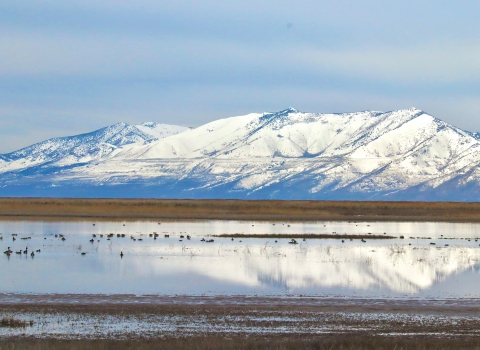HONOLULU — The U.S. Fish and Wildlife Service (Service) has published a draft recovery plan for 15 species endemic to the Island of Hawaiʻi. All 15 of these species are listed as endangered under the Endangered Species Act and face threats of urban development, habitat loss, competition and predation from invasive species invasive species
An invasive species is any plant or animal that has spread or been introduced into a new area where they are, or could, cause harm to the environment, economy, or human, animal, or plant health. Their unwelcome presence can destroy ecosystems and cost millions of dollars.
Learn more about invasive species , drought, fire, and effects of climate change climate change
Climate change includes both global warming driven by human-induced emissions of greenhouse gases and the resulting large-scale shifts in weather patterns. Though there have been previous periods of climatic change, since the mid-20th century humans have had an unprecedented impact on Earth's climate system and caused change on a global scale.
Learn more about climate change , and naturally occurring events like hurricanes, earthquakes, volcanic activity, and tsunamis. This draft recovery plan addresses the threats these species face and the proposed plans to help them towards recovery. This draft recovery plan will be open for a 60-day public comment period.
Recovery plans allow the Service and partners to strategize the best course of actions to prevent the extinction of species and support their recovery. This plan addresses 13 endangered species and subspecies of plants and two invertebrates that are found no where else in the world. These species were listed under the Endangered Species Act on October 29, 2013.
Achieving recovery for the 15 species will require assessments of populations and their habitat, selection of sites for long-term conservation, managing of threats, development of regulatory protections (e.g., increased biosecurity regulations), species-specific research, and conservation translocation to maximize resiliency, redundancy, and representation. The recovery strategy for each species group or species is presented in the main body of the Draft Recovery Plan Document.
Recovery and long-term protection of all 15 species will require collaboration with federal, state, county, nonprofit, and private stakeholders to develop adaptive management and monitoring plans for each species' habitats, threats, and biosecurity. Some species may require conservation translocation to historical, restored, or created habitats suitable to achieve the resiliency necessary for a species to thrive.
The public comment period will be available for 60 days. An electronic copy of the draft recovery plan is available at: https://ecos.fws.gov/docs/recovery_plan/SIGNED%20-%20Hawaii%20Island%20dRP%20(20221108).pdf
To request additional information or submit written comments, please contact the field supervisor.
- Attention: 15 Hawaiʻi Island Species Draft Recovery Plan, Pacific Islands Fish and Wildlife Office, 300 Ala Moana Boulevard, Room 3122, Honolulu, HI 96850.
- You may send comments by email to megan_laut@fws.gov. Please include “15 Hawaiʻi Island Species Draft Recovery Plan” in the subject line.
In order to be considered, comments on the draft recovery plan must be received on or before January 9, 2023. All comments and materials received will become part of the public record associated with this action. The Service will accept comments received or postmarked on or before January 9, 2023.
###
The U.S. Fish and Wildlife Service works with others to conserve, protect, and enhance fish, wildlife, plants, and their habitats for the continuing benefit of the American people. For more information, visit www.fws.gov/pacificislands, or connect with us through any of these social media channels at https://www.facebook.com/PacificIslandsFWS, www.flickr.com/photos/usfwspacific/, www.tumblr.com/blog/usfwspacific or www.twitter.com/USFWSPacific.



